Grenada Kite Festival
and
West Indies Kite Workshops
Easter 1998
"Dancing Frog Designs Goes to Grenada"
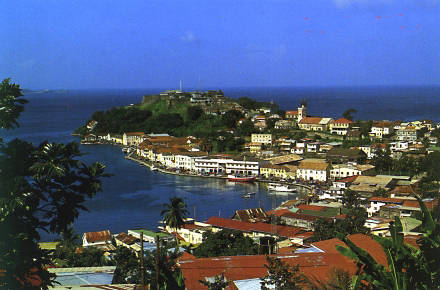
|
|
|
Jennifer Snyder and Bob Harris of Dancing Frog Designs set off for Easter in Grenada to attend the local kite festivities. We heard there were local kite festivals in the West Indies around Easter and were curious about them. We love the Caribbean and wanted to see what sort of kites they flew in the West Indies and attend their kite festivals. We contacted Dario Sandrini of KIDO Foundation, an environmental group on the island of Carriacou just North of Grenada. Dario said if we were willing to write up a proposal the powers that be in the West Indies would sponsor our coming down for the festivities. So Jennifer and Bob offered to make kites with the kids a lá J.R. Tolman. We contacted J.R. who kindly set us up with some materials and instructions to make 150 of his Sode and Tulka kites using paper, bamboo sticks from roll up shades, computer labels, and adding machine tape. We thought this would be great for kids aged 6-8, as Jennifer has assisted J.R. in many of his workshops and teaches art to kids.
|
|
|
For the older children we wanted a more challenging kite, so out of the same materials we fashioned a paper and bamboo kite similar to our Jumping Frog kite. This was adapted from a silk and bamboo frog kite we had seen from China. This kite turned out to be a great hit.
|
|
|
As the emails continued to flow it became apparent that one of our sponsors was the Embassy of the Republic of China (Taiwan). Taiwan, has been donating money to Grenada for roads, a trade center, a youth center, and more. In addition the ROC has helped sponsor the annual kite festival for the past 5 years. As a result they decided to help arrange for our stay in Grenada. Fresh from the Smithsonian Kite fly at the Washington Monument, we set off to Grenada. After one night to adjust to the island, we set off on a catamaran ferry, the Osprey, for the 1.5 hour journey to the island of Carriacou, KIDO foundation, and a week of kite making with the children. Carriacou is a relatively unpopulated island of about 7,000 with very little water, and not much industry or tourism. The roads are rough and there are very few vehicles. So we were trucked into the 5 schools on the island by the one truck owned by the Department of Agriculture. For three days we did two schools a day making kites with the children.
|
|
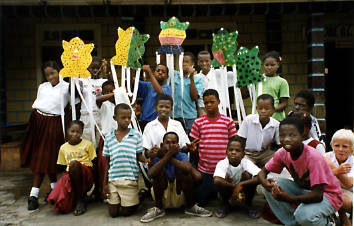 |
|
|
|
|
The schools we taught kite making workshops in were:
- L'Esterre Rosary School
- Harvey Vale Primary School
- Dover Primary School
- Mt. Pleasant Primary School
- Hillsboro Primary School
- and then a ferry ride to Petit Martinique Primary School
|
|
|
|
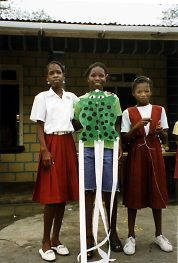 |
|
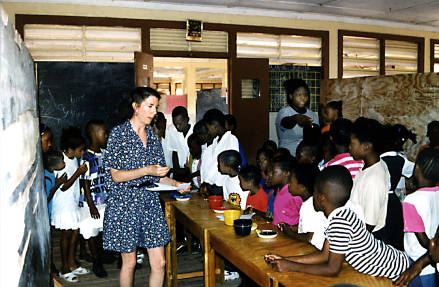 |
|
|
During the 1.5 - 2 hour workshops we worked with groups of 5 kids to a kite. We brought sponges, brushes and powdered Tempera for painting the kites. Once the designs were painted on the kites and dried we affixed the sticks with computer labels, added the adding machine tape tails, and made the bridles. In the West Indies the bridle is called a Compass.
It was a wonderful experience having the kids surround us while we all made kites. They were so excited. Their faces all aglow. You could tell this was a kite culture. And they were excited about making a new kind of kite. The little ones were just happy to have any kite, so the simple Sodé was just great for them. And to have all the choices of colored tempera to choose from. By chance Jennifer chose to bring the tempera colors of the Grenadian flag, red, yellow and green. We also had blue and black. We worked intensely for an hour and a half and then flew the kites with the kids right in the school yards. We photographed them and then off we went to another school. Basically we taught two schools each day and finished by 2 in the afternoon. The children were so wonderful it was exhilarating.
When we first landed on Carriacou we gave a radio interview. Because Jennifer was on the radio, girls who normally are not kite fliers, wanted to come and make kites with us. They told their parents, "See the lady on the radio makes kites, I want to make one too".
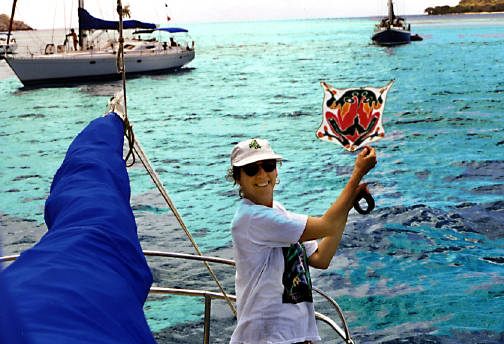
Jennifer flying our Jumping Frog kite, sailing to Petit Martinique
The island of Petit Martinique is the smallest of the 3 West Indies Islands with about 1000 fisherman, boat workers and their families. Because it was such a small community it felt like home. We met the Coordinator for the Island, Sharron Roberts, who filled us in on the history and social make up. Water is in short supply as it is in Carriacou. So cisterns are the main water supply, and it seems the weather has been getting drier the past few years with El Niño. Only a short distance away is the island of Petit St. Vincent where rooms go for $700 a night!!. So it is only a matter of time before a desalination plant moves into Petit Martinique and tourism begins. It is a beautiful relaxed undeveloped spot right now.
On our last day in Carriacou a tiny kite festival was set up on the windy side of the island at Dover school. A DJ and music was brought in. We met one of the old time boat building families, Minnie McLawrence-Bethel and her two handsome sons. They had entries for the biggest kite (12' made of bamboo poles and paper from used cement sacs), smallest kites, and prettiest kites.
|
|
|
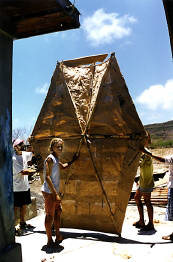 |
|
|
|
|
|
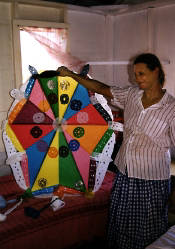 |
|
The prettiest kite entries were tissue paper appliqué in which finely cut out designs were glued to white tissue background. Very delicate. And then more decorations around the outside border of the kite. This family had been winning the competitions for several years and were very proud of their entries. We first learned about the "Mad Bull" from the McLawrence-Bethels.
|
|
The traditional island kite is similar to one made all over the Caribbean. It is a hexagonal kite, which has been elongated and then the top section is bowed to form the "nose". The line which tensions the nose is also where the hummer or "Mad Bull" is attached. This is either tissue paper or cellotape attached to the bowline which vibrates in the wind, or "Sings". Then a long tail is attached to the bottom of the kite. The tail is about a 20 to 1 ratio to the length of the kite and is attached to a line that hangs from the lower two points of the hexagon. The tail material is usually made from strips of cotton fabric torn up and tied in knots to form the lengths needed.
|
|
|
|
|
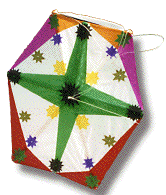 |
|
|
|
Two tails are flown on a kite. For a very big kite three or four tails are used. The bridle is a three point bridle with the top two points attached to the top two corners of the kite and the third point attached to the center of the kite. |
|
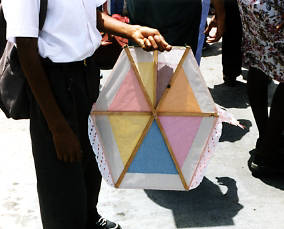 |
|
|
|
| A local kite maker told us that if bamboo is used to make the kite, they bridle the kite higher because the bamboo will flex and still be stable. If strips of wood are used, then the kite is bridled lower which makes the kite more stable, and pull harder. |
|
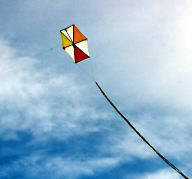 |
|
|
There is a variation to the normal or "nose kite" as it is referred to. This variation has about 12 points on it instead of the normal 6 and is fully symmetrical, forming a circular kite with a bowed nose. This is called the "Moon kite", though much less prevalent than the normal hexagonal kite.
We returned to Grenada after a great week making kites on Carriacou, and took a day off. We were treated to a nice hotel room at the former Soviet Embassy, overlooking the beautiful white sand beach of Grand Anse. This was about a 2 mile beach with turquoise water. We were above the beach on a bluff in a small cottage with kitchen and bedroom and a view of the beach, and the setting sun to the West.
|
|
|
|
The breezes and temperature made a perfect setting. The next day we met a young child outside the hotel flying his kite over the houses and hotels on about 1500 feet of nylon line. The flying line is a nylon 3-ply line from Korea used for fishing. The weight of the line varies with the kite size, but generally fliers measure how far out a kite is by the number of balls of line they use. The winder is usually a simple stick and the line is wound in a figure eight in the middle of the stick followed by two or three circular wraps at the top, another figure 8 around the middle and then two more wraps around the bottom. All the children and adults used this same method of wrapping line. It was so natural for them they obviously learn it at a young age. |
|
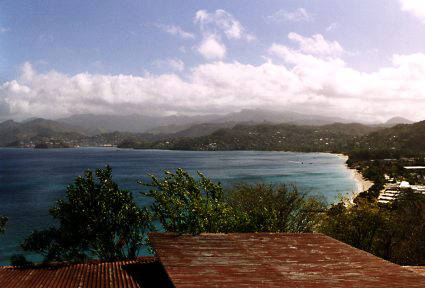 |
|
| We had a two mile walk down to the bus stop for rides into the main town of St. George's. Along the way we'd see the land crabs scurry |
|
|
|
|
|
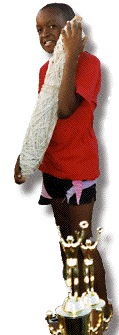 |
|
across the turf to their holes. The cattle were grazing along the roadside, traffic was very light. People were more often than not walking along the road, with occasional cars running by. When we came to the main road and the bus stop, busses and taxis would stop and ask us if we wanted a ride. A bus in Grenada was more like a Nissan mini van, and held about 15 people. There would be a driver and a money taker who opened the door and let people off and on. The best part was the full blast Reggae playing constantly. Big bass sounds. Made the rides a moving experience. Cost was about $.25 US for a ride to town.
The next morning we began our workshops in Grenada. Cecil Greenidge is the director of the program, and one of our sponsors. |
|
|
|
We set up shop at the Youth Development Center, which was newly built for the children of Grenada by the ROC. Since it was now Easter week, school was out, and the children were bussed into the center. We gave workshops for two days and were on television, radio and in the newspaper. Children came early and stayed late and made several kites. It was so windy we did a lot of kite hospital "repairs". One child, Karim came early each day and stayed late. On the last day he showed up with his father Dancer Boy and made beautiful kites all day. Dancer Boy was the winner of the "Large Kite" category in the competition in previous years. It was wonderful to meet other kite crazy folk. Karim at the end of the last day asked if he could come home with us... We were so touched. We will always remember his smiling face.
|
|
|
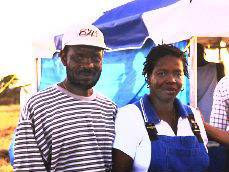 |
|
|
|
On the last day of workshops we went to the Queen Elizabeth orphanage and made kites with the children. They had so much fun and were so thankful to have us come make kites with them that it was really touching. We decided to leave all the remaining art supplies with them.
|
|
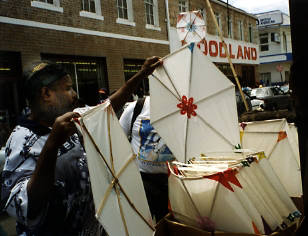 |
|
|
|
| Kites being sold in St. George's Farmers Market |
|
|
The next day was Good Friday, which is really a major kite day in the lower Caribbean. Neighbors at the hotel who were from Barbados and Guyana informed us this is the day when everyone in their countries goes out and flies kites. So on Good Friday we toured the Island with our Taiwanese hosts, Walter Chang and his daughter Jennifer (4 years old). Everywhere we went we saw children walking around with kites. Our waiter the night before said that's the way many Grenadians celebrate Good Friday. They put up kites and tie them off and leave them up flying for the next week, all singing away on 1500 - 2000' of line. Of course on the down side we met folk who would say, "I was up all night, couldn't sleep. There was a "Mad Bull" over my house all night". We loved them and listened for the Mad Bulls all the time. It was really cool to hear kites before you can spot them.
|
|
|
|
As we drove around the island we came to one area where someone was flying a "Man kite". These are tissue and bent bamboo kites made in the shape of people. Of course just as we were taking pictures of it, there was a large commotion in the background. Someone's bull had gotten loose and was chasing everyone down the beach. A real Mad Bull.
On Easter Monday the formal Kite Competition was held. It was sponsored by the Youth Development Center, the Minister of Tourism office, and the Republic of China, Taiwan. The competition was held on a narrow point of land on the southern end of the island at Fort Jeudy. Here the winds from the Atlantic sweep over a narrow isthmus about 500 yards wide and 1/4 mile long. There is a steep drop over the leeward side, so you have to get your kites well up or they can get sucked down into the ocean. There were several tents set up for the judges and refreshments and of course the obligatory sound system playing Reggae (this year's favorite song was "Who let the Dogs out, woof woof woof"). Jennifer was honored to be a judge. Contestants paid $.33 to enter and were given a number. Judges went around the flying field and rated the kites. Rather a loose and fun way to judge.
|
|
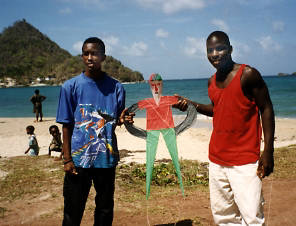 |
|
|
|
Categories were:
- Smallest kite-1/2"
- Largest kite-10'
- Most creative kite
- Best Flying kite
- Best sounding kite.
- Most colorful kite
|
|
|
|
|
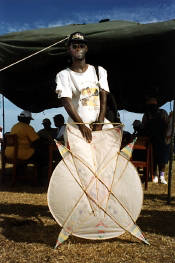 |
|
One family cleaned up. Grandma won the most creative with a kite that had crocheting on the front, the granddaughter won with smallest kite, and the other sons and children had honorable mention.
A few people arrived late because of work. In typical fashion "honorable mention" prizes were given to them because the kites were so special. The whole affair was a giant tailgate party with barbecue, cooking and food on the flying field, and lots and lots of kites sitting up in the 30 mph wind, just singing. It was the most beautiful site, with around 2000 people. What a fabulous way to spend Easter ascending.
|
|
We wish to thank the Grenada Ministry of Tourism, the Grenada Board of Tourism, Mr. Cecil Greenidge, Director of the Youth Development Center, Ambassador David Lin of the Republic of China for their assistance and help with this project.
We also wish to thank John Francis of Planetwalk for his introduction to KIDO Foundation and honor him for all his support concerning ecological issues, especially those pertaining to the marine habitat.
|
|
|
|
|
|
|
|
|
|
|
|
|
|
|
|
|
|
|
|
|
|
|
|
|
|
|
|
|
|
|
|
|